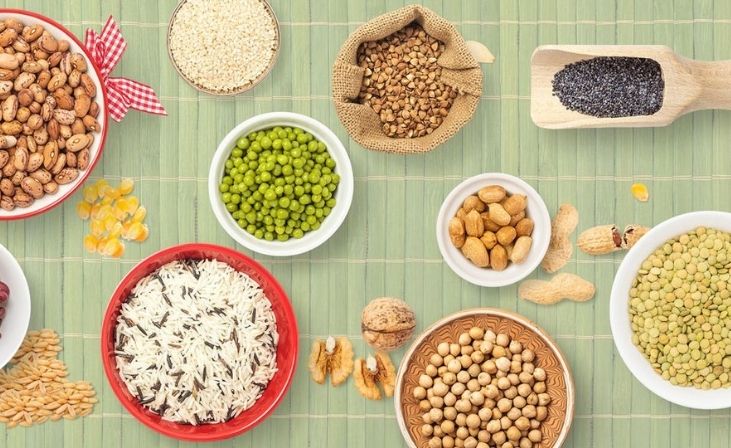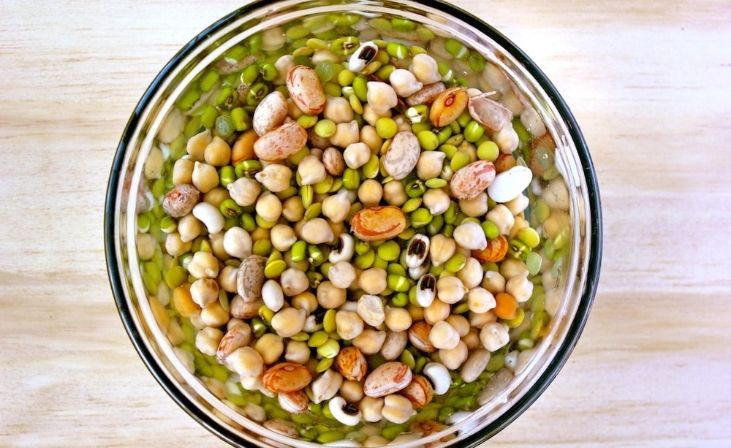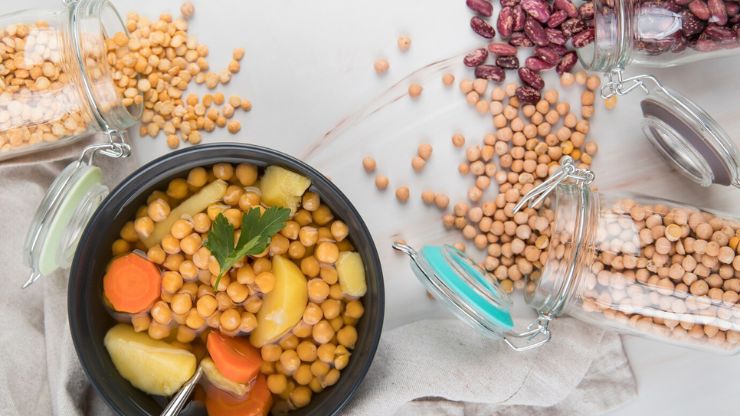Imagine a world where gas and bloating were never an issue after eating bean dip! Or where rice and bread didn’t sit so heavy in your stomach. Where are these foods supposed to cause such adverse reactions we have all grown accustomed to? Or could the answer to pain-free eating be found in something as simple as fermenting?
Throughout all of human history, fermented foods and fermenting practices have been the staples of people groups and cultures. There isn’t a single people group that can be thought up that does not share this similarity.
One of the most commonly shared traditions includes whole grains and legumes before consuming. This practice encompasses soaking, sprouting, or sour leavening in an acidic environment to “liven up” the dormant food.
Today we are going to talk about the soaking process.
This practice has many benefits that may have been unknown to our ancestors, but thanks to modern studies, we can witness the very power of fermentation! It’s also EXTREMELY EASY TO DO!
This blog post delves into the art and science of soaking whole grains and legumes to enhance their digestibility and nutrient absorption. We’ll explore why soaking is important, how to do it effectively, and the potential benefits it offers for your digestive health. Whether you’re a seasoned cook or new to the kitchen, understanding the magic of soaking can elevate your culinary creations while promoting better digestion and overall well-being.
Table of Contents
ToggleWhy to Soak Your Grains?
In essence, the age-old practice of soaking grains, sometimes referred to as culturing, serves a dual purpose. It effectively breaks down antinutrients and the challenging-to-digest elements of grains while simultaneously releasing valuable nutrients.
The process of soaking grains is straightforward and simply requires a bit of advance planning. The outcome is a whole-grain food that’s not only highly nutritious but also easy on the digestive system, offering a delightful and robust flavor.
Now, let’s dive in and explore the straightforward steps to embark on the rewarding journey of soaking grains.
Quick Link: How to Make Yogurt in a Slow Cooker
Benefits of Soaking Grains and Legumes:

Whole grains are a valuable source of complex carbohydrates, dietary fiber, and essential B vitamins like niacin and B6. Additionally, they contain important minerals such as calcium, iron, phosphorus, potassium, and zinc. However, there’s a catch: naturally occurring compounds in grains can make them challenging to digest and hinder the absorption of these vital minerals. For some individuals, especially those with compromised digestion, consuming complex carbohydrates in grains can lead to discomfort, including pain, bloating, and digestive distress. This is where soaking whole grains comes in, offering a solution to make these nutrients more accessible and easier on the digestive system.
When grains are soaked, it triggers a series of beneficial reactions. First, this process activates an enzyme called phytase. Phytase’s primary role is to break down phytic acid, which tends to bind essential minerals like iron, calcium, and zinc. As phytase works its magic, it releases these minerals from their phytic acid bonds, making them more available for your body to absorb. Additionally, soaking is the initial step in sprouting grains, which takes this mineral-releasing process even further, resulting in grains that are even richer in essential nutrients.
While most individuals with a balanced diet that includes meat, fish, and vegetables usually meet their mineral requirements, if you’re concerned about mineral intake, adopting the practice of soaking or sprouting your grains can be a sound strategy to enhance your nutritional intake.
Apart from enhancing mineral absorption, soaking grains also activates another enzyme known as amylase. This enzyme plays a vital role in breaking down the complex starches found in grains. These complex starches can sometimes pose challenges for digestion, particularly for individuals with sensitive stomachs. When these starches are broken down through soaking, sprouting, or sour leavening followed by cooking, grains tend to be easier on your digestive system. This explains why sourdough bread, especially when made from ancient grains like spelled, is typically gentler on digestion compared to quick-rise whole wheat bread. It’s also why sourdough bread is often permitted on a low-FODMAPs diet.
Moreover, the soaking process leads to the conversion of phytic acid into lower-order inositols, with myo-inositol playing a crucial role. These micronutrients contribute to blood sugar balance, metabolic health, and hormonal equilibrium. Their impact is especially remarkable for women with polycystic ovarian syndrome (PCOS), where they are utilized as therapeutic supplements to enhance fertility, regulate hormones, and manage blood sugar.
Myo-inositol, in particular, aids in blood sugar regulation and shows promise in managing type 2 diabetes. Animal studies have demonstrated that the inositols found in soaked and sprouted grains can improve insulin sensitivity in individuals who are insulin-resistant, underscoring their significant potential for overall health and well-being.
How It’s Done
All it takes is a little bit of planning ahead and a good routine to establish a system for fermenting all your whole grains and legumes before you consume them. Whether you’re into rice, millet, buckwheat, quinoa, black beans, pinto beans, or chickpeas, the process is pretty much the same and really, very simple.
Don't just scroll, subscribe!
BuzzTrail's unique web-stories are the cure for boredom you've been waiting for.
8-12 hours before you’re going to cook up a fabulous meal simply rinse your grains or legumes and place them in a mason jar with 1-2 Tablespoons of an acid. An example would be lemon juice, apple cider vinegar, whey, kefir, or kombucha.
If I am using a quart-sized jar I use 1 TBSP, but I typically ferment my grains and legumes in half-gallon mason jars adding 2 TBPS to each jar. This creates a nice acidic environment to assist in the breakdown of the phytates.
Cover your grains or legumes with non-chlorinated water, then top that jar with your handy airlock system and let nature take its course!
When your 8-12 (or sometimes 20 hours if you didn’t get around to them) hours are up and you are ready to cook, rinse the grains and legumes well discarding the water they have been sitting in. Add some gelatin-rich bone stock and some filtered water for cooking.
You can also choose to move to the sprouting stage at this point, which we will discuss in another post.
Also Read: Top 6 Gut Healthy Recipes
Effective Soaking Whole Grains

The process of soaking whole, unprocessed grains, like brown rice, is surprisingly simple. It involves using warm filtered water mixed with a small quantity of an acidic medium. This technique effectively breaks down the challenging-to-digest elements of the grain while unlocking the valuable nutrients it contains. (I prefer to warm the water using a tea kettle until it’s comfortably warm to the touch, avoiding scalding temperatures.)
The general guideline is to use enough warm water to cover the grains, along with a small amount of an acidic medium for every cup of grain. You have the flexibility to choose between a dairy-based acidic medium, such as whey, or a dairy-free alternative like lemon juice or apple cider vinegar. After that, securely cover the mixture and let it soak overnight, or for a maximum of 24 hours.
Note for Cold Weather Soaking: During cold weather, you can place your soaking rice in the oven with only the oven light turned on. The oven light generates some heat, creating a cozy environment for soaking. Then, remember to drain, rinse, and cook the rice, preferably in bone broth and butter for added flavor and nutrition.
Effective Soaking Legumes
The traditional method for preparing beans involves soaking them in hot water, ideally warm to the touch but not boiling, for a minimum of 12-24 hours. It’s essential to change the soaking water at least once during this period, followed by a thorough rinsing before the prolonged cooking process. Generally, the combination of soaking and cooking helps reduce approximately 20-50% of the phytic acid content, with the reduction dependent on the duration of the soak.
Opinions on whether an acidic medium is necessary vary. Based on my personal experience, as well as that of many others, I tend to favor the option of not using an acidic medium in this case. Adding an acid medium often diminishes the flavor and texture of the beans.
Experts recommend an extended bean-soaking process of up to 36 hours, with the soaking water changed regularly and the beans rinsed thoroughly at least every 12 hours. Additionally, it’s advised to introduce a phytase-rich medium during the bean soak to further enhance phytic acid reduction. For individuals who consume beans more than once or twice a week, following these instructions can help maintain a balanced phytate intake.
Tips to Keep In Mind
- Don’t overpack your jars. Your grains and legumes will likely grow to just about double their size in the soaking process.
- Mix your legumes around in the jar evenly distributing the water throughout so they don’t get all stuck together on the bottom of the jar
- It’s best to cook grains and legumes in bone broth and add plenty of healthy fats such as butter, ghee, or coconut oil before consuming. This not only aids the digestive process, but the fat soluble vitamins will help you absorb more of the now readily available minerals that have been woken up by the soaking process!
- Cooking time can be shaved down a bit since you soaked your grains and legumes already softening them up! BONUS!
Efficiency Tips From a Mom
Make it a nightly routine to soak some oats for the morning pot of oatmeal, rice for the evening stir fry, as well as the twice-weekly batch of pinto beans for tacos or kidney beans for chili.
Always keep a batch of fresh, gelatin-rich stock on hand to cook your grains and legumes in. This way if you are ever in a pinch, you at least added some nutrient dense broth to assist in the digestion process.
Having a weekend day for soaking, sprouting, fermenting and then refrigerating makes the week a breeze!
Final Words
Incorporating the practice of soaking whole grains and legumes into your cooking routine is a small change that can yield significant benefits for your digestive health. As this blog post has shown, the art of soaking is a time-honored technique that enhances the digestibility of these dietary staples and unlocks their full nutritional potential. By addressing common questions and concerns about soaking, we hope to empower you with the knowledge to make informed and health-conscious culinary choices. So, next time you plan a meal with whole grains and legumes, remember the transformative power of soaking to elevate your dishes and support your overall well-being.
So go ahead!
Enjoy that bean dip, gas-free!
Eat that slice of bread and know that your body will rejoice and not grieve over the digestive process!
FAQs
Why is soaking whole grains and legumes essential for better digestion?
Why is soaking whole grains and legumes essential for better digestion?
Soaking is crucial as it helps break down compounds like phytic acid and enzyme inhibitors found in these foods. This makes the nutrients more bioavailable and eases digestion, reducing potential discomfort.
How long should I soak whole grains and legumes, and is there a specific method to follow?
How long should I soak whole grains and legumes, and is there a specific method to follow?
The soaking duration varies by type, but a general guideline is to soak for at least 8 hours or overnight. The method usually involves covering them with water and adding an acidic medium (like vinegar or yogurt) or warm water.
Can soaking reduce the cooking time of whole grains and legumes?
Can soaking reduce the cooking time of whole grains and legumes?
Yes, soaking can reduce cooking time. It softens the grains or legumes, making them quicker to cook. Be sure to adjust cooking times accordingly, as soaked grains and legumes may require less time on the stove.
Are there any side effects or downsides to soaking whole grains and legumes?
Are there any side effects or downsides to soaking whole grains and legumes?
Soaking is generally safe and beneficial. However, some people may experience slight changes in taste or texture. Experimentation is key to finding the right soaking method that suits your preferences.

